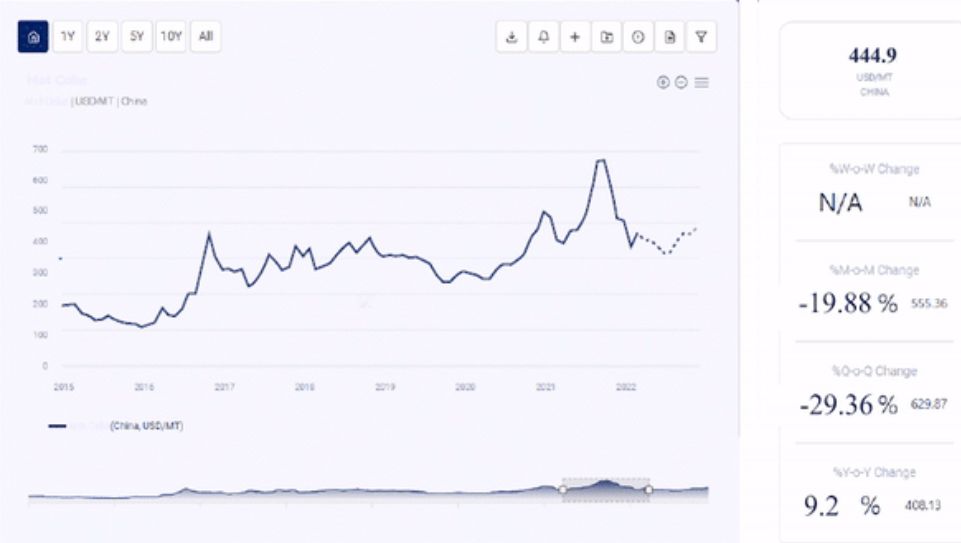| Report Features | Details |
| Product Name | Isobutene |
| HS CODE | 29012990 |
| Supplier Database | BASF, Evonik, LyondellBasell Industries., Global Bioenergies, ExxonMobil |
| Region/Countries Covered |
|
| Currency | US$ (Data can also be provided in local currency) |
| Post-Sale Analyst Support | 360-degree analyst support after report delivery |
Request for Real Time Isobutene Prices: https://www.procurementresource.com/resource-center/isobutene-price-trends/pricerequest
Isobutene is an alkene with a four-carbon branching chain that is highly flammable and colourless and has a gasoline-like odour. The central nervous system may be harmed by extended exposure, and some evidence of carcinogenic activity has also been found.
Isobutene is used to make gasoline with a high-octane rating. Isobutene can cause frostbite when it comes into contact with the skin. As a liquefied gas, isobutene is transported. Isobutene has a mass per molecular weight of 56.10 g/mol.
By catalytically dehydrating isobutane in the presence of a sufficient catalyst, isobutene is produced. As a highly endothermic and pressure- and temperature-limited process, obtaining a high yield of isobutene needs a relatively high temperature and low pressure.
Key Details About the Isobutene Price Trend:
Procurement Resource does an in-depth analysis of the price trend to bring forth the monthly, quarterly, half-yearly, and yearly information on the isobutene price, tin plate price and dihydro myrcenol price etc. in its latest pricing dashboard. The detailed assessment deeply explores the facts about the product, price change over the weeks, months, and years, key players, industrial uses, and drivers propelling the market and price trends.
Each price record is linked to an easy-to-use graphing device dated back to 2014, which offers a series of functionalities; customization of price currencies and units and downloading of price information as excel files that can be used offline.
The isobutene price trend, pricing database, and analysis can prove valuable for procurement managers, directors, and decision-makers to build up their strongly backed-up strategic insights to attain progress and profitability in the business.
Industrial Uses Impacting Isobutene Price Trend:

The industrial uses of isobutene are in the production of tyres, hoses, adhesives, and sealants are what drive its price trend. Antioxidant production also uses isobutene as a production intermediary.
Key Market Players:
• BASF
• Evonik
• LyondellBasell Industries.
• Global Bioenergies
• ExxonMobil
News and Events:
• September 06, 2021: New enzymes have recently been created to increase the production of renewable isobutene.
Related Reports:
- Isodecanol Price Trend - https://www.procurementresource.com/resource-center/isodecanol-price-trends
- Isononanol Price Trend - https://www.procurementresource.com/resource-center/isononanol-price-trends
- Isophorone Diisocyanate Price Trend - https://www.procurementresource.com/resource-center/isophorone-diisocyanate-price-trends
About Us:
Procurement Resource offers in-depth research on product pricing and market insights for more than 500 chemicals, commodities, and utilities updated daily, weekly, monthly, and annually. It is a cost-effective, one-stop solution for all your market research requirements, irrespective of which part of the value chain you represent.
We have a team of highly experienced analysts who perform comprehensive research to deliver our clients the newest and most up-to-date market reports, cost models, price analysis, benchmarking, and category insights, which help in streamlining the procurement process for our clientele. Our team track the prices and production costs of a wide variety of goods and commodities, hence, providing you with the latest and consistent data.
To get real-time facts and insights to help our customers, we work with a varied range of procurement teams across industries. At Procurement Resource, we support our clients, with up-to-date and pioneering practices in the industry, to understand procurement methods, supply chain, and industry trends, so that they can build strategies to achieve maximum growth.
Contact Us:
Company Name: Procurement Resource
Contact Person: Chris Byrd
Email: sales@procurementresource.com
Toll Free Number: USA & Canada - Phone no: +1 307 363 1045 | UK - Phone no: +44 7537 132103 | Asia-Pacific (APAC) - Phone no: +91 1203185500
Address: 30 North Gould Street, Sheridan, WY 82801, USA









